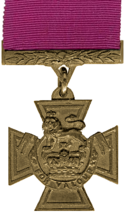Arthur Batten-Pooll
Arthur Hugh Henry Batten-Pooll | |
|---|---|
 | |
| Born | 25 October 1891 Knightsbridge, London |
| Died | 21 January 1971 Ivybridge, Devon |
| Buried | St Lawrence's Churchyard, Woolverton |
| Allegiance | |
| Service | |
| Years of service | 1911 - 1919 |
| Rank | Captain |
| Unit | Somerset Light Infantry 5th (Royal Irish) Lancers Royal Munster Fusiliers |
| Battles / wars | World War I Russian Civil War |
| Awards | Victoria Cross Military Cross |
Arthur Hugh Henry Batten-Pooll VC MC (25 October 1891 – 21 January 1971) was an English recipient of the Victoria Cross, the highest and most prestigious award for gallantry in the face of the enemy that can be awarded to British and Commonwealth forces.
He was 24 years old, from Bath and was previously an officer with the Somerset Light Infantry and the 5th (Royal Irish) Lancers. He had requested to be transferred to an infantry regiment where one was likely to see action, was then a Lieutenant in the 2nd Battalion of The Royal Munster Fusiliers, British 1st Division during the First World War when the following deed took place for which he was awarded the VC.:
"On 25 June 1916 near Colonne, France, Lieutenant Henry-Batten-Pooll was in command of a raiding party when, on entering the enemy's lines he was severely wounded by a bomb which broke and mutilated all the fingers of his right hand. In spite of this he continued to direct operations with unflinching courage. Half an hour later during the withdrawal, while personally assisting in the rescue of other wounded men, he received two further wounds, but refusing assistance, he walked to within 100 yards of our lines when he fainted and was carried in by the covering party."[1]
He later achieved the rank of captain.
His Victoria Cross is displayed at the National Army Museum, Chelsea, London.[2]
References
- ^ "No. 29695". The London Gazette (invalid
|supp=(help)). 4 August 1916. - ^ Location of grave and VC medal
External links
- Use dmy dates from April 2012
- 1891 births
- 1971 deaths
- 5th Royal Irish Lancers officers
- Royal Munster Fusiliers officers
- British Army personnel of World War I
- British World War I recipients of the Victoria Cross
- Recipients of the Military Cross
- People from Knightsbridge
- People educated at Eton College
- Fellows of the Linnean Society of London
- Alumni of Balliol College, Oxford
- Somerset Light Infantry officers
- British Army personnel of the Russian Civil War
- British World War I prisoners of war
- World War I prisoners of war held by Germany
- British Army recipients of the Victoria Cross
